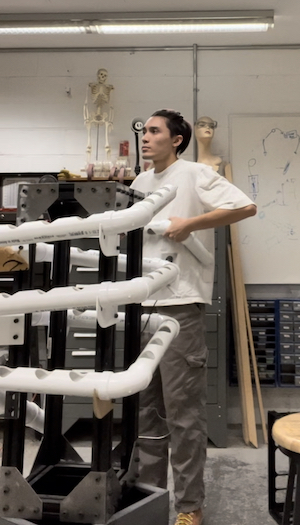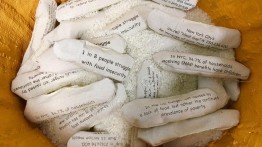Designs for the Future of Food
POSTED ON: August 3, 2023
In a first-year engineering design class, Cooper Union students reimagined oyster shells as bricks, corn husks as paper, scraps of beets and red cabbage as paints, fruit skins as leather wallets, and, believe it or not, spoiled milk as thread. “I never thought they’d make that work,” Amanda Simson, an associate professor of chemical engineering who teaches the course, says of this last idea. “But they did.”
Since 2020, students in her section of Engineering Design and Problem Solving (EID101) have tackled Re-Envisioning Waste—a topic she selected to encourage them “to think about where they’re getting materials and reflect on the broader ways we use things and throw them out.”
In a multitude of ways, The Cooper Union is taking on the real-world issue of food sustainability: Architecture students and faculty are addressing waste and sustainability through design, contributing to last fall’s acclaimed Tallin Architecture Biennale (TAB) that reflected on food and the construction of circular economies. farming practices, repurpose materials, and help curb carbon emissions. Meanwhile, alumni are working on the front lines, finding ways to produce higher quality food with less impact on the environment.
Food sustainability has garnered increasing attention as the world’s population—and food insecurity—grows even as concerns mount over agriculture’s outsize impact on the environment. According to the World Bank, the current agriculture system generates as much as 29 percent of total greenhouse gas emissions. The pandemic also has thrown a harsh spotlight on the weaknesses in food production and distribution systems (remember those empty supermarket shelves?), making the call to address food sustainability even more urgent.
“We’re pressed for time with global warming and how much waste is generated by the food industry,” says Nada Shetewi, a chemical engineering junior who took Re-Envisioning Waste. In the class, she explored brewery wastewater treatment with microbial fuel cells, which generate electricity as a bonus. “I’ve always been interested in environmental issues and waste management. It was a unique opportunity to do research and get hands-on experience bringing an engineering project to life.”

Another sustainability project is MUDBUG, which stands for Multiuse Data Acquisition Bio Unit Group. Brandon Bunt BSE’22, a mechanical engineering master’s student, leads the club, which was created last year. Its goal: develop an affordable sensor that would wirelessly send data to a phone about soil quality—all as a way to advance organic farming and traditional techniques. “It would be like a little bug you throw into the soil,” he says, adding the group already has a prototype. He believes the technology has the potential to help farmers make better-informed decisions about their soil compared with slower methods of lab testing, empowering them to wean their operations off petrochemical fertilizers.
Bunt got the bug for MUDBUG while studying abroad in Guatemala as an undergraduate in 2021. “I realized there’s lots of engineering problems in agriculture that need a lot of work,” the 2021 Benjamin Menschel Fellow says, “and it’s not necessarily just throwing the newest technology at the problem. We should look at Indigenous farming practices and how to marry modern technology to make them more efficient, so we can wean ourselves off chemical fertilizers, chemical pesticides, and monoculture-based farming practices.”
In a companion Vertically Integrated Project (VIP) course, students are further honing the technology. Offered since 2020, the VIP program allows undergraduates to work on various large-scale research projects over several semesters, with an interdisciplinary approach—bolstering Cooper’s strategic goal of courses and projects that bring together students from engineering, architecture, and art.
“I wanted to involve students in research as early as possible, for the mentorship and to understand what research is about,” says Neveen Shlayan, associate professor of electrical engineering, MUDBUG club adviser, and coordinator of the VIP program. “It’s another way for students to express themselves and find their passion.”
Meanwhile, Data Science and Design Projects for Social Good has for the sixth year partnered students from art and engineering with nonprofits to analyze large data sets and distill the information into visuals (maps, charts, graphs) and even full-scale installations.
“We have this unique opportunity to have very different but very talented students working together,” says Sam Keene, an electrical engineering professor who co-taught the course this past semester with Aden Bailey A’19. “It’s one of the ways Cooper can differentiate itself.”
Bailey, a founding designer at a healthcare startup, actually took this very class as an undergraduate. She says it exposed her to the work world and career possibilities—benefits she hopes her own students will reap. “It was one of the first classes that felt so real-world, felt like I was having an impact,” says Bailey, whose project focused on recidivism for the Center for Employment Opportunities and whose first job was as a graphic designer for City Harvest. “I had a client depending on me. It kicked off my interest in doing product design and user experience. It gave me an introduction into how to understand people’s work from other disciplines. That’s something I use every single day.”
Interest in the study of food can be traced to Cooper’s early history. In the late 1860s, professional cook Pierre Blot—one of America’s first celebrity chefs—conducted cooking demonstrations in the Great Hall, hoping the college would establish a school of gastronomy, according to Peter Buckley, a retired associate professor of history and The Cooper Union’s unofficial historian. Alas, it didn’t work. Fast-forward to around 2000, when Buckley first taught the Social History of Food to explore food production and consumption from 1492 to the present, with an emphasis on the passage of New World foods (sugar, wheat, beef) across the Atlantic into Europe and Asia.
“When I first proposed it, food was not seen as being nearly as important historically,” he says. “But since then, it’s become completely central to social and political discourse.” After 20 years, the course remains popular, so much so that Buckley adjunct-taught it again this past spring and has shifted the focus to global cuisines. Students examined a different city (Kyoto, Goa, Charleston, Lyon, and more) each week, studying its food culture as well as how history shapes our experience of food.
Over in The Irwin S. Chanin School of Architecture, Lydia Kallipoliti, associate professor of architecture, co-curated TAB 2022, which was titled Edible; Or, the Architecture of Metabolism, and taught a course by the same name. She also organized the EDIBLE conference in November, bringing TAB participants to Cooper to debate the intersection of architecture, food systems, and regenerative design.
“It’s not possible to persist in having linear modes of production and distribution,” she says. “It’s not sustainable to continue life in that way. We wanted to offer viable alternatives to how design could intervene in creating different cycles of production to address the fragility of the production and distribution processes.”
Hayley Eber AR’01, acting dean of the School of Architecture, and Mae-Ling Lokko, a former Cooper Union adjunct professor now at Yale University, co-taught a workshop last year that inspired the TAB installation Everything’s on the Table, created by Cooper architecture students. It disrupts waste by reinventing the typical dining table as a 12-foot-long butcher block set with culinary prototypes, to harvest, store, and transform cooking castoffs. The perimeter of a cast-iron pan, for example, collects, stores, and reuses animal fat. Vases grow herbs from vegetable tops or hold coffee grounds that feed oyster mushrooms. Overhead, meats cure in drying chambers.
“It was very much a living table,” Eber says. “Things were reconstituted, reused, reharnessed. The whole premise was a production landscape and that our role at the table is not just to be there and be fed. We have agency. We can participate in the food cycle.”
Last summer, Sanjana Lahiri AR’22, now a designer at Sage & Coombe Architects in Manhattan, worked as a curatorial intern with Kallipoliti and organized the TAB research section, inspired by a seminar called Archaeology of Architecture and Food Systems that looked at the burdened history of colonization and food as well as women’s roles in the kitchen.
“The experience was great,” Lahiri says. “As a whole, the biennale was essentially framing issues of climate change, resources, production, and waste through the lens of food. I think showing these large issues on such an intimate scale humanizes stuff and allows people to see these issues in a different way.”







